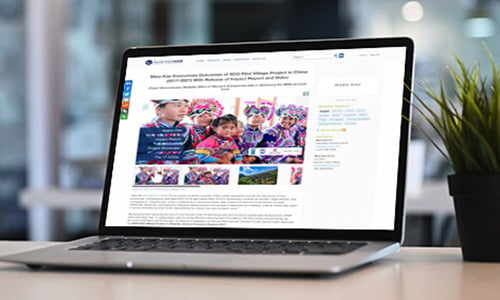Events are an important part of every company’s marketing outreach. Now that many events have become virtual, you might be considering a webinar. Webinars are an ideal way to reach audiences, both live and on-demand. After producing many successful webinars, we wanted to offer Business Wire’s four tips and eight best practices.
- What are your goals for the webinar? Are you trying to generate leads? Are you trying to reassure current customers about product quality or service availability? Are you launching a new product or service? Are you educating your audience about a topic? Whatever the reason, understand the purpose. The purpose will help you with messaging, positioning, and ensuring that you are solving a problem or a need for your customers. Write down clearly defined goals and how you will measure those goals. Ensure that your teams are clear about the purpose and measurement.
- Choose your audience and how to reach them. As communicators, you know that when it comes to events, attracting your target audience is of paramount importance. Use the following questions to refine your webinar’s target audience. Who are you trying to reach with this webinar? Are you trying to reach a broad audience or a focused audience? Is there are certain demographic that you want to communicate with? How you are going to reach this audience? Is this an audience one you already communicate with or do you need to build a list to reach your target audience? Do you need to partner with someone to reach this group? Once your audience is defined, and you know how to reach them, move on to the next step.
- Pick a topic that resonates. Not only must the topic resonate, but you need to be clear about what you will be communicating. This is your opportunity to be a thought leader, to demonstrate your expertise. Ensure that the topic is on-brand. Tie your topic back to your audience. Ensure you are fulfilling a need, answering a question, or solving a problem for your audience.
- Is your presenter an expert? Your presenter needs to be an expert on the topic and be comfortable presenting. If you decide a panel is best, who will moderate the panel? Do your panelists give credibility to your topic and resonate with your audience? Most often, if the topic is on point, people will want to ensure they are getting value from the speakers. Credibility is key; trust is not a commodity. If your experts aren’t credible, you will lose trust and credibility from your audience.
Now that you have chosen your audience, topic, and presenters, it’s time to set up the webinar. Here are some best practices to consider.
- Do you have a webinar platform? Yes, you might be using Zoom, Go-to-Meeting, or WebEx for your internal meetings, but do you have a webinar platform? Many online meeting platforms limit the number of attendees or the length of time you can host an event. Make sure your platform supports webinars or upgrade your platform to support webinar functionality.
- Pick the date and time. Again, think about your audience. Where are they? Are they global or local? Pick a date and time that works across your audience’s time zones. Don’t forget to consider other webinars that might be going on at the same time in your peer group. In terms of days of the week, there are no magic dates or times. For example, we know some people are concerned about holding webinars on Mondays. Monday might still be a great day for your webinar, but maybe not at 8 am. The right timing is about your audience and your market.
- Promote your webinar.
- Create a landing page so audiences can register quickly and easily. Don’t ask for too much information with your sign-up form. Stick to name, email address and company name.
- Create digital assets that you can place on paid platforms.
- Write a clear and concise invitation that highlights the benefits of joining the webinar. Be specific, tell invitees what they will learn from you. Don’t forget to include the date, time and a link to sign up. Confirm the webinar with people who have signed up and remind people to attend.
- E-mail your existing customers and prospects who have opted in to communicate with you. Promote your webinar often. To maximize visibility and RSVPs resend your email to those who didn’t open your original email.
- Create a hashtag to centralize social discussions.
- Promote the webinar across your social channels. Have employees and participants share your posts and don’t forget to ask your partners to promote the webinar.
- If you have panelists, pre-write messaging and create marketing assets they can use to promote the webinar across their channels.
- Send out a news release promoting the webinar.
- Rehearse. Use rehearsal times to double-check that each speaker’s webinar environment is appropriate. Lighting, sound, background are all things to test at this time. If you are doing a panel session, make sure the panelists are comfortable with the questions you plan to ask. You want to make your panelists look good and not surprise them with a rogue question. Make sure they are prepared to answer your questions succinctly and concisely.
- Going live! It’s Webinar Day. You have prepared well, and have a great webinar planned. Check-in with your panelists, make sure their equipment is plugged in and working. Many webinar platforms mute audiences; keep your audiences muted during your presentation. Take a deep breath and push the start button. Make sure you record the webinar so you can send it to those who couldn’t attend. Once live, share your hashtag to allow users to live-tweet your brand content. If you are allowing questions, explain how you want those questions to come to you. Be sure to remove questions designed to trip up panelists or moderators. It is fine to not answer all the questions that are submitted. You can always use questions not answered to deepen customer relationships by providing them to sales teams for follow up.
- Post-webinar. Congratulations, you did it! Make sure you follow up with your audience. Thank them for attending, send them the recording of the webinar. If you had panelists, don’t forget to thank them.
- Re-use the content. You hosted a terrific webinar and generated very useful information. Now it is time to repurpose your webinar into a wide range of usable content pieces. From blog posts, guides, Q&As, to tip sheets and soundbites. Repurposing is a great way to remind your audience about the topic and to gain greater traction in communicating with them.
- Debrief. Your team came together and produced a great program. Take the time to debrief with them. What could have been done better or differently? Remember to measure your results. Did you achieve your goals? What adjustments should you make for next time?
We hope these tips and best practices deliver results. Promote your webinar by using a news release distributed by Business Wire. For more information contact us at info@businesswire.com or 888-381-9473.
Hinda Chalew is VP of Product Marketing at Business Wire. She has spent more than 20 years producing, speaking and moderating webinars and other events.
Get the latest PR, IR, Marketing and Media tips on the Business Wire Blog. Subscribe today!





